There are very few people who would not face such problem as warts on the body. These growths can occur on the body in teenagers, adults, and the elderly. Usually, warts are just a cosmetic problem, altering a person's appearance. And it is only in rare cases that these formations pose a real threat to health.
What is a wart?
Our skin has a smooth surface. However, in some cases, protruding skin growths may appear on it. They are called warts. These are usually lifelong formations that do not change for many years.
The mechanism of appearance of warts is the growth of the top layer of the skin. The sizes of the formations range from 1 mm to several centimeters. This parameter depends on the type of formation and its localization on the skin. There is often a fusion of several warts. The color of the growths on the skin is usually flesh, but they can take on other shades, for example pink or brown.
Medicine classifies warts as benign neoplasms. They do not grow and do not penetrate the surrounding tissue.
In the International Classification of Diseases, the following codes are assigned to warts:
- B07 - viral wart,
- A63. 0 - venereal wart,
- L82 Seborrheic keratoma
Most types of warts are viral, sexually transmitted warts are venereal, and seborrheic keratomas are senile warts that are non-infectious in nature.
The following skin lesions should be distinguished from warts:
- nevus (moles),
- calluses,
- malignant tumors,
- basal cell carcinoma,
- large warts resulting from syphilis.
Some of these formations can be fatal. Therefore, if a suspicious formation appears on the body, it is necessary to consult a doctor.
Why do warts appear?
Usually, a viral infection is the cause of warts. The process of appearance of warts takes place as follows. The human papillomavirus enters the skin cells and causes them to divide rapidly. As a result, a growth or papilloma develops on the skin. However, there are types of warts that the virus has nothing to do with.
Strictly speaking, papilloma does not always occur on the skin. Often these formations are found on the mucous membranes, inside the bladder, in the larynx, on the cervix, etc. However, it is customary to call warts only papillomas that appear on the skin.
Warts can be located on any part of the body. However, some species have their favorite places. For example, warts usually form in the groin and anus; acrocords prefer skin folds in the upper body.
The human papillomavirus does not multiply outside the body. However, it can persist for a long time in hot and humid places. That is why people can often get infected with it when they visit baths, saunas, swimming pools. But the virus does not live long in the open air - it is neutralized by ultraviolet radiation from the Sun.
According to studies, around 80% of the world's population is infected with some type of human papillomavirus. There are a total of two hundred strains of these viruses. Some viruses are relatively harmless, others lead to papillomas, and others can even cause malignant tumors. Some strains can be passed from person to person. Therefore, some types of warts can be contagious. But transmission of the disease by frogs and toads, as well as other representatives of wildlife, contrary to popular belief, is impossible. This is because animal papillomaviruses do not multiply in the human body.
You can become infected with a new type of virus through personal contact, handshaking, sharing of household items (for example, towels), when visiting public places (swimming pools, baths, saunas, transport), by smallinjuries and sexually.
The papilloma virus that has entered the body does not always cause the onset of the disease. Usually the factors associated with the disease are stress, decreased immunity (for example, due to infectious diseases). At the same time, the virus can stay in the body for several years and wait behind the scenes.
Varieties of warts
Doctors distinguish several types of warts:
- ordinary (vulgar),
- young (flat),
- pointed (condyloma),
- senile,
- skinny.
Birthmarks (nevi) should be kept separate from these types of warts. Usually, birthmarks do not protrude above the surface of the skin and are dark in color, although there are exceptions.
Common warts
This type of warts occurs in 70% of cases. It is caused by the papilloma virus. Externally, vulgar (ordinary) papillomas look like small, semicircular formations on the surface of the skin. They are usually completely painless. The size of the formations varies from several mm to 1 cm, and their surface is usually uneven, bumpy, often resembling the surface of a cauliflower. Color - flesh color, greyish, yellowish brown. Frequent locations - hands, face, fingers, lips, knees, elbows. The mucous membranes are rarely affected.
Often, ordinary papillomas can go away on their own. The peculiarity of this type of papillomas is that they often develop not alone, but in groups. You can often find a large papilloma, around which small ones grow. If you remove the larger (maternal) papilloma, the smaller ones usually go away.
Common papillomas can occur at any age. They often occur in school-aged children.
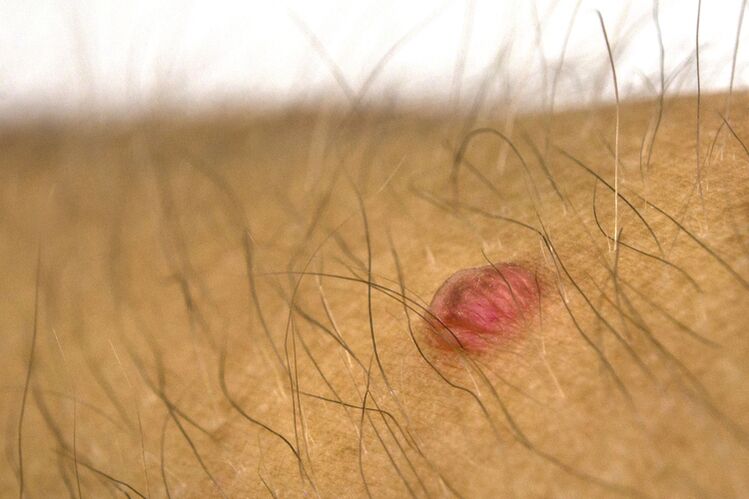
Teenage warts
This type of papilloma usually occurs in children and adolescents. But in middle-aged people, they can also appear. These papillomas are also often called flat papillomas. They represent only 4% of all warts.
They are often found within easy reach. They can also be seen on the feet and face, near the fingernails, between the toes, on the legs and on the neck. They are often associated with hormonal changes in the body. Like ordinary papillomas, they do not pose a significant danger and can go away on their own. They usually don't cause physical discomfort, but they can make the appearance worse.
Flat papillomas are usually flesh colored and protrude only slightly above the surface of the skin (about 1 to 2 mm). They can reach a diameter of 5 mm, but they are generally smaller than the common ones. Flattened papillomas can appear near wounds and cuts. Usually, juvenile papillomas have a smooth surface and uneven, although well-defined, borders. Due to the absence of a stratum corneum on the surface, they can appear shiny.
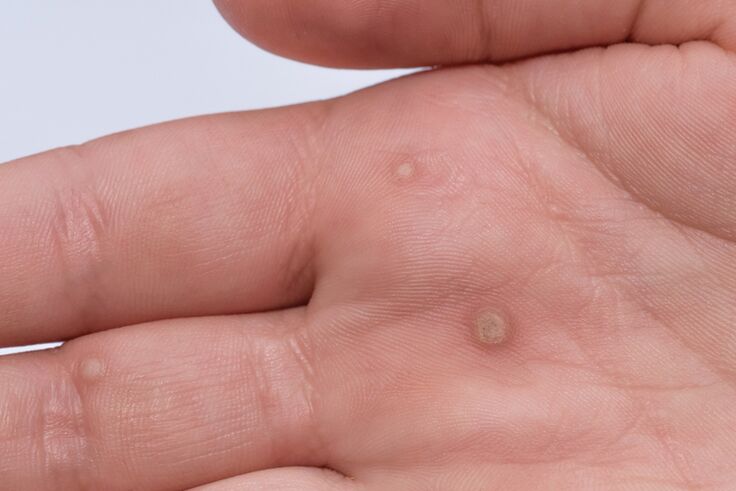
Plantar warts
This is an extremely unpleasant type of skin growth that occurs on the feet. Sometimes they are mistaken for corns. However, plantar papillomas have one trait that sets them apart from corns. If a plantar wart is damaged, it usually bleeds. For corns, this phenomenon is not typical. Although on the outside, papillomas on the legs can look like calluses - they are usually hard and keratinized. Their color is usually dirty gray, dark yellow or dirty with a brown tint. Black dots may appear on their surface.
Most often, a plantar wart is found on the leg. But they can also meet in groups, as well as grow together. Plantar papillomas grow not only outside the skin, but also deeper.
Externally, warts of this type can look like ordinary warts. They usually have a semi-circular shape. However, if a person constantly develops such a skin formation, then it can take a flattened shape.
The appearance of papillomas on the soles of the feet has little to do with age, they can appear in both young and old alike. These formations can also be observed in children.
Plantar papillomas can cause discomfort and even severe pain when walking. When you step on such a growth, it feels like you are stepping on a small pebble. Externally, warts can sometimes look like thorns. Hence, people call this type of papilloma thorns.
In a calm state, these formations can be itchy. Like other types of papillomas, plantar warts develop under the influence of the papilloma virus. The virus often enters the skin of the feet from the environment. For example, it is not uncommon to catch this virus while visiting a swimming pool without rubber shoes. Uncomfortable shoes also contribute to the appearance of skin lesions, as they often occur in places where the shoes rub the feet. Profuse sweating and poor foot hygiene are also contributing factors.
It is not recommended to touch papillomas on the soles of the feet with your hands, as this can transfer the virus to other areas of the skin.
Plantar warts treatment
Sometimes papillomas of this type can go away on their own. This happens in about half of the cases. But sometimes it takes a long time to wait for this moment, and not everyone can afford it, especially if the upbringing is painful sensations. If a growth on the foot causes sharp pain, does not allow walking, then it must be removed. In addition, educations larger than 1 cm should be removed. The removal operation can only be performed in the doctor's office.
If in doubt that the formation on the leg belongs to any type of papilloma, the doctor can perform a number of diagnostic procedures. These include scraping and analysis of the stratum corneum, PCR analysis for the presence of the papilloma virus genome. To determine the shape and size of the formation, an ultrasound is performed. Warts on the leg require a differential diagnosis from syphilis warts. However, usually thorough diagnostic measures are not performed, since it is not difficult to diagnose papilloma on the leg.
Sometimes drugs can be tried to remove a growth on the foot. For the removal of warts, preparations based on salicylic acid, necrotizing agents, cooling sprays and special plasters are suitable. However, elimination with medication is usually not a quick procedure. You can quickly remove a wart on the sole of the foot only with the help of tools available in medical institutions. These can be methods:
- laser,
- surgical,
- electrocoagulation,
- cryodestruction,
- radio wave.
Any type of procedure has its own advantages and disadvantages. The surgical method, for example, is mainly used for large skin growths, as it severely injures the skin.

Genital warts
It is a special type of wart. They are usually found in the genital area. Their shape is also unusual, since they resemble taste buds (hence their name). However, warts can also be irregular in shape, resembling cauliflower or rooster crest. The viruses that cause this type of warts are usually transmitted sexually. Also, condylomas can be observed on the mucous membranes, in the anus. Therefore, these warts are often referred to as anogenital or venereal. Less commonly, condylomas are found in the armpits, in women under the mammary glands. Warts are flesh to pink in color. Sometimes several genital warts can grow together. In addition, condylomas of this species can grow to large sizes. Warts can cause painful sensations during intercourse, defecation. If they are injured, they can bleed. Women with genital warts can also develop cervical cancer.
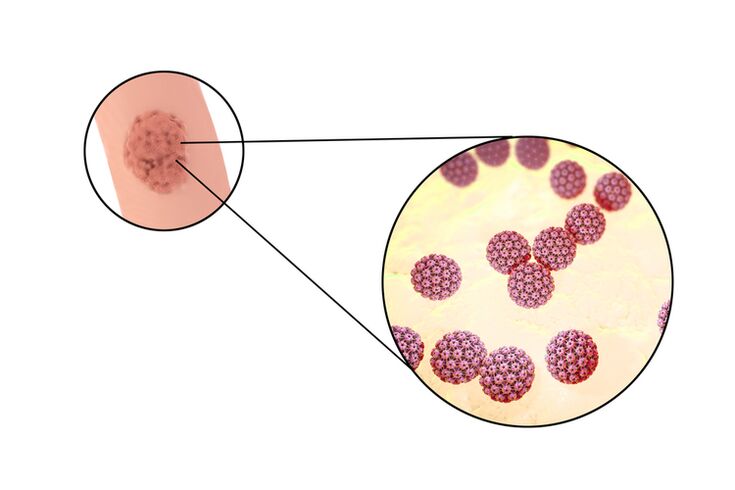
Filiform warts
This type of wart is extremely common. Filiform warts, or acrocords, often grow in large groups. Prefer acrocords for areas with thin skin. It is the area of the armpits, neck, shoulders, eyelids, wings of the nose. Can occur in the groin area, under the mammary glands in women. They usually don't bother a person or hurt, but they can itch.
Externally, filamentous warts look like long threads. However, acrocords are often found that have a thin threadlike stem, to which a thick body is attached, usually spherical or hemispherical. They are also threadlike. These warts are called pendulous.
Most warts of this type vary in size from 1mm to 5mm. There are also acrocords larger than 1 cm, sometimes several filamentous warts grow together.
Acrocords are rare in children. They are typical of people over 35. And over the years, their number usually increases. In people over 70 years of age, this type of warts is observed 100%. The tendency to have a large number of hitches on the body can also be inherited. Acrocords are often associated with being overweight. In women, they can occur during pregnancy.
Filamentous warts have an unpleasant feature. If a filamentous wart is pulled out, a new one will soon grow in its place. Acrocords rarely pass on their own. Their appearance is promoted by increased sweating, reduced immunity.
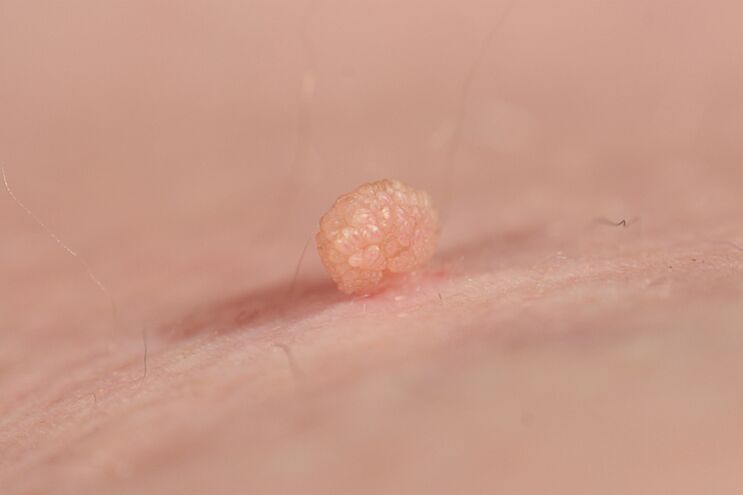
Senile warts
This type of wart has another name - seborrheic keratoma. It usually occurs in people over the age of 60. Unlike other types of warts, senile keratomas are not caused by the human papillomavirus. The exact reasons for their occurrence have not been established. Keratomas are most likely associated with age-related changes in the body. They develop from the basal layer of the epidermis, which is why they are often called basal cell papillomas. Although that's not quite the correct name, as true papillomas are only caused by viruses. Heredity plays an important role in the emergence of these neoplasms. Senile keratomas can often look like melanoma. Therefore, if they occur, it is necessary to consult a doctor so that he can diagnose. However, senile keratomas usually do not require treatment and do not develop into malignant tumors.
Externally, keratomas look like pink or yellowish papules with a thickness of 1 to 2 mm. Their size varies from 2 mm to 3 cm. Sometimes warts of this type grow to a size of 4 to 6 cm. Keratomas have a greasy, easily removable crust. Their surface is uneven, as if it were wavy. As they grow, keratomas often become like a fungus cap and their color changes to black or dark brown. Their surface becomes hard, they can crack.
Most often, keratomas are located on the neck and chest. Can be observed in groups. They appear less frequently on the hands and face. They do not exist on the mucous membranes. Usually there are no more 20 keratomas. If a person has a lot of senile warts, it is often due to hereditary factors.
Senile keratomas do not go away on their own. People with excessive amounts of seborrheic keratomas on the body are advised to increase the amount of vitamin C in their diet to prevent further growth. You should also avoid direct sun exposure, overheating, hypothermia, stress.
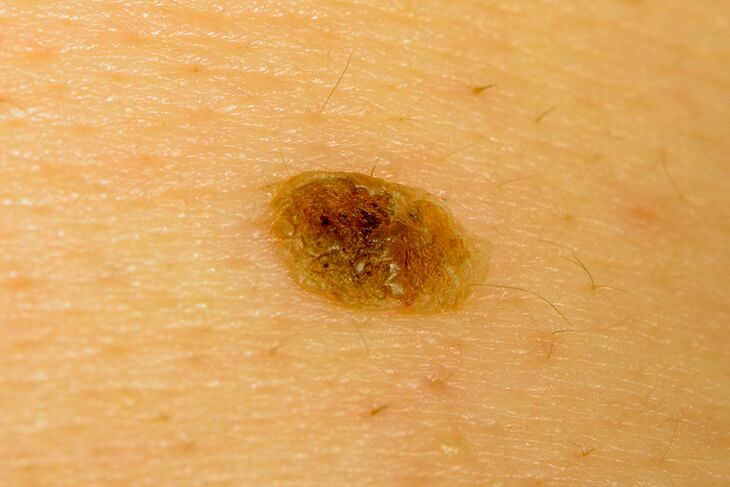
Treatment
Most papillomas do not pose a serious threat. However, after an injury, they can hurt, bleed. After that, there is a risk of developing malignant tumors. Although in papillomas and keratomas the risk of malignant transformation is much lower than in moles.
Papillomas are usually treated by ablation (surgical, using a cold high-frequency electric current or a laser). Therapeutic treatments are generally less effective.
The indication for removal is pain of skin formation, large size, bleeding, change in shape, location in an uncomfortable place (for example, on the tip of the toe, on the soles of the feet, in the genital area), aesthetic considerations. Warts are also prone to elimination.














































































